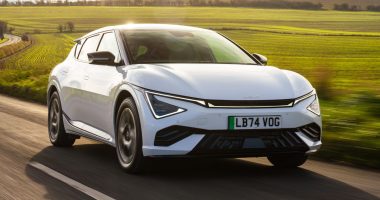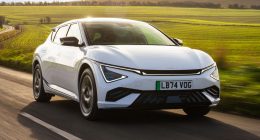Ever wondered what the letters HR-V stand for? Well, wonder no more. They’re an abbreviation for ‘High-rider Revolutionary Vehicle’. Based on previous attempts, Honda has been guilty of over-hyping revolutionary, so is it a case of more of the same with this all-new version?
Table of Contents
A CASE OF THIRD TIME LUCKY?
The Honda HR-V is a vehicle that feels as though it has been around a lot longer than it has but in actual fact, this is only the third-generation of this medium-sized SUV and on initial viewing it does create a favourable impression. There is a choice of three models – ‘Elegance’, ‘Advance’ and the range-topping ‘Advance Plus’ we are testing here – with prices starting at £29,410 and rising to a snip under £35,000. Overall, the styling has more than a hint of Mazda about it, especially the side profile and the headlamps’ silhouette, although that’s no bad thing. Around the back, the window swoops down aggressively to meet a cool-looking, full-width LED light bar. All HR-Vs sit on 18-inch wheels and have a smart body-coloured front grille instead of the traditional chrome finish seen on its rivals. ‘Advance Style’ is differentiated by silver roof rails, a black contrast roof and dark door mirror caps.
IS THE CABIN AS COOL?
On the round, Honda’s designers have done a great job of signing off on a dash that is smart, well-made and simple to figure out whether you are parked or on the move. The 9-inch touchscreen is a big step up compared to Honda systems of before and – thankfully – those assigned to bring this car to market have resisted the need for all functions to be operated through it. Therefore, you still have a row of traditional buttons and switches directly beneath it to control heating and ventilation. We aren’t as convinced by the part-digital driver display. Owners can change the inner section of the left dial to show various bits of real-time information, whereas the speedo is old-school analogue. Standard equipment is comprehensive and includes a reversing camera, LED headlights and auto sensing wipers. Dual-zone climate control, an auto-dimming rear view mirror, a heated steering wheel and automated tail-gate all come on mid-spec HR-V cars and above. Wireless phone charging, a premium audio system and part-leather upholstery are reserved for ‘Advance Style’, meanwhile.
HOW SPACIOUS IS THE HR-V?
Less than what you would probably expect and the reason is two-fold. Firstly, the middle section of the back seat is raised and narrow – a combination that makes it uncomfortable to sit on even for short periods of time. Secondly, headroom is pretty average and that is a direct consequence of that rakish roofline, so it’s a cramped experience for taller passengers. Acres of leg room, map pockets on the back of the front seats that also include a section to store your mobile phone, and USB charge points are all redeeming features. Buyers will also enjoy utilising the universally-liked cinema-style seats in the back where the squabs pivot upwards to free up room beneath the seats. The cargo area is well-shaped and has a minimal load lip and 16-litres of additional under floor storage. But again, considering the HR-V’s target audience, the 319-litre load space is much smaller than many rivals’ and top-spec ‘Advance Style’ lose a further 15-litres. Folding the 60/40 split rear seats down leaves owners with a 1,289-litre load space and an all-important flat floor.
A LOOK UNDER THE BONNET
The Honda Jazz shares the same ‘e:Hev’ set-up with the HR-V and in both, the petrol-electric hybrid system ranks as one of the most enjoyable and very best we have tested to date. The engine is a 1.5-litre, four-cylinder but in light of the SUV’s extra weight it has been uprated to 129bhp. Also bigger is the battery pack to give a fairly decent EV range in built-up areas. When the two e-motors come on grid, the 0-60mph dash is covered off in 10.6 seconds – decent performance for a car the prioritises family over fun and one that promises 52 miles-per-gallon on the combined cycle. The system seamlessly switches between petrol, electric and petrol-electric but a word of warning if you need a burst of acceleration: the relative calm is shattered as the revs are sent through the roof, more so if ‘Sport’ mode is selected. Vibrations through the pedals and the steering wheel are other drawbacks in this situation. However, if you read the road ahead, and plan your overtake, then this is much less of an issue.
COMFORT IS THE WORD
The HR-V doesn’t pretend to be anything it isn’t from a driving perspective: safe, predictable and assured are three words that perfectly sum up this Japanese people mover. It is perched on a soft suspension that, for the most part, mops up lumps and bumps without breaking into much of a sweat and pleasantly wafts you along with little wind or road noise worth talking about. That bias-towards comfort doesn’t necessarily mean the HR-V is as dull as dishwater to be at the wheel of as the steering is perfectly judged while a fairly taut body dials only the most extreme body roll.
PROS AND CONS
+ Bold, likeable styling
+ Efficient hybrid powertrain
+ Kit levels are strong
– Noisy petrol engine
– Tight rear headroom
– Cargo area is small
ENGINE: The hybrid set-up found under the bonnet of the Jazz is carried across to the HR-V and is largely identical, save for more power from the 4-cylinder petrol motor and a larger battery that guarantees a mile’s worth of EV driving at town speeds. Of all the self-charging systems currently on the market, the one bearing Honda’s name ranks as one of the most polished and efficient.

STYLING: Our ‘Advance Style’ HR-V gets a whole host of styling enhancements, including a two-tone roof, contrast door mirror caps and silver-effect roof rails. Customers can choose from a trio of design packs, two optional 18-inch wheel profiles and one of five body colours. If you settle for the ‘Premium Sunlight White Pearl’ shade then be prepared to pay an extra £850 for the privilege.

INTERIOR: Every HR-V features a 7-inch digital driver display and a 9-inch multimedia touchscreen which, again, is shared with the Jazz. From a user perspective the infotainment package is simple to figure out even if it’s not as responsive as it could be. Perceived quality is definitely one of the car’s undisputed strengths; the design is intriguing and the materials are plush and soft to touch.

PRACTICALITY: This is one area that really lets the side down. Room for the driver and front seat passenger can’t be faulted but it’s a different story for those travelling in the back, taller people especially. Head room is stingy at best and the shape and height of the rear bench’s middle section is unforgivable. Boot space is also average, although the cinema-style rear seats are a big bonus.

SPECIFICATION
Price: £34,850 (as tested)
Engine: 1.5-litre petrol plus two e-motors
Power/torque: 129bhp/187lb ft
Transmission: e-CVT, front-wheel drive
0-62mph: 10.7 seconds
Top speed: 106mph
Economy/CO2: 52.3mpg/122g/Km









